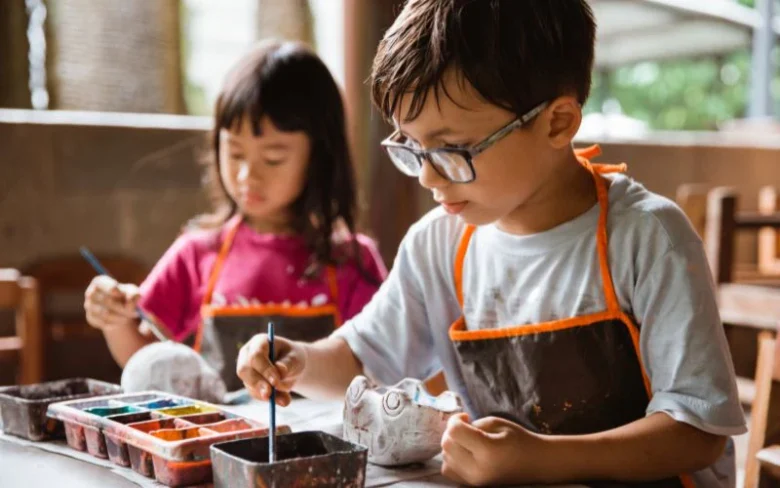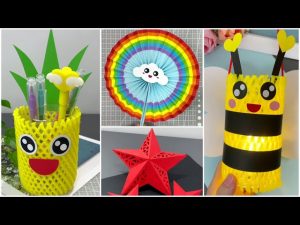In a world dominated by digital devices, the art of crafting offers a refreshing break for both young and old. Kid crafting is more than just an enjoyable pastime; it is an enriching activity that offers numerous developmental benefits for children. From enhancing creativity to improving fine motor skills, crafting can be a pivotal part of a child’s growth. This guide aims to inspire parents, educators, and craft enthusiasts to discover the joys and advantages of kid crafting. Together, we’ll explore easy projects, understand crafting’s role in development, and how it can be integrated into learning.
Introduction to Kid Crafting
Kid crafting involves creating art and crafts with children using various materials, such as paper, glue, paint, and natural objects. It’s a fun way to spend time together while encouraging children to express their inner artist. Crafting has surged in popularity among parents and educators due to the countless benefits it provides. Not only does it help develop fine motor skills, but it also promotes creativity, critical thinking, and problem-solving abilities.
The rise of DIY culture and the availability of crafting materials have made it easier than ever for families and educators to engage children in crafting activities. Crafting fosters a sense of accomplishment and pride in children, boosting their confidence and eagerness to explore new ideas. With the growing emphasis on holistic education, crafting has become a crucial component of childhood development, providing a platform for learning, experimenting, and creating.
Top 10 Easy and Creative Crafting Ideas for Kids
Crafting doesn’t have to be complicated to be effective. Here are ten simple yet imaginative crafting projects that will captivate children’s attention and spark their creative spirit.
- Paper Plate Animals
Transform ordinary paper plates into vibrant animal faces using paint, markers, and craft paper. Children can create their favorite animals or invent their own creatures, honing their artistic skills while learning about different animals.
- DIY Bird Feeders
Make a simple bird feeder using pine cones, peanut butter, and birdseed. This project connects children with nature, teaching them about wildlife while developing their hand-eye coordination.
- Homemade Playdough
Create colorful playdough using flour, salt, water, and food coloring. This tactile activity strengthens fine motor skills and provides a platform for imaginative play, allowing kids to mold shapes and figures.
- Egg Carton Flowers
Recycle egg cartons into beautiful flower bouquets with paint and pipe cleaners. This environmentally-friendly craft encourages creativity and resourcefulness while producing stunning results.
- Sock Puppets
Turn mismatched socks into playful puppets with buttons, yarn, and fabric scraps. Puppet-making allows children to express themselves through storytelling and character creation.
- Nature Collages
Gather leaves, flowers, and twigs to create stunning nature collages on cardboard. This craft fosters an appreciation for the environment and encourages children to explore the world around them.
- Origami Animals
Introduce children to the art of origami by crafting simple paper animals. Origami enhances spatial awareness and patience as kids follow step-by-step instructions to fold paper into charming figures.
- Rainbow Bracelets
Use colorful beads and elastic thread to create beautiful rainbow bracelets. This craft supports fine motor skills and offers a chance for self-expression through jewelry design.
- DIY Wind Chimes
Craft wind chimes using recycled materials like bottle caps and seashells. Hanging them outside provides children with sensory experiences as they listen to the gentle sounds created by their handiwork.
- Painted Rock Creatures
Collect rocks and transform them into vibrant creatures with acrylic paint. This craft allows kids to experiment with colors and patterns, fostering artistic expression and creativity.
The Importance of Creativity in Child Development
Creativity plays a vital role in a child’s development. It nurtures their imagination, enabling them to think outside the box and find innovative solutions to problems. Engaging in crafting activities stimulates brain development, enhancing cognitive abilities and promoting intellectual growth.
Crafting promotes self-expression, allowing children to convey their thoughts and emotions through art. It offers a safe and supportive environment where children can explore their identities and experiment with new ideas. Encouraging creativity from a young age helps cultivate a lifelong love for learning and discovery.
Furthermore, creative activities like crafting build resilience in children. The process of trial and error teaches them to persevere in the face of challenges, fostering a growth mindset and a positive attitude towards learning. By instilling creativity in children, we equip them with essential skills for success in an increasingly complex world.
Crafting as a Learning Tool
Crafting is not only a fun activity but also a powerful educational tool. Integrating crafting into educational settings enhances learning experiences, making lessons more engaging and memorable for children. Craft-based projects can complement various subjects, from math to science, encouraging students to apply their knowledge in creative ways.
For instance, crafting geometric shapes out of paper helps children understand mathematical concepts like symmetry and spatial relationships. Creating models of the solar system offers a hands-on approach to learning about astronomy. Crafting can also be used to explore historical events, allowing students to recreate artifacts and deepen their understanding of the past.
Incorporating crafting into the curriculum fosters collaboration and teamwork among students. Group projects encourage communication and cooperation, helping children develop essential social skills. By integrating crafting into education, teachers can create dynamic and interactive learning environments that cater to diverse learning styles.
Tips for Parents and Educators on Encouraging Kid Crafting
Creating a crafting-friendly environment is essential for encouraging children to engage in creative activities. Here are some practical tips for parents and educators to inspire kid crafting:
- Designate a Crafting Space
Set up a designated area for crafting, stocked with essential supplies like paper, scissors, glue, and paint. Having a dedicated space encourages children to craft independently and freely express themselves.
- Provide a Variety of Materials
Offer a diverse range of materials for crafting, including natural objects, recyclables, and traditional art supplies. The more options children have, the more likely they are to experiment and explore their creative potential.
- Incorporate Crafting into Daily Routines
Schedule regular crafting sessions as part of daily routines, such as after-school activities or weekend family time. Consistency encourages children to view crafting as an integral part of their lives.
- Encourage Imagination and Exploration
Allow children to take the lead in crafting projects, encouraging them to use their imagination and explore new ideas. Avoid imposing strict guidelines, and instead, provide support and guidance as needed.
- Celebrate Achievements
Display completed crafts in a prominent location, such as a fridge or classroom wall. Celebrating children’s achievements boosts their confidence and motivates them to continue crafting.
Kid Crafting in the Digital Age
In today’s digital age, technology plays a significant role in crafting. Online resources, tutorials, and digital tools provide endless crafting possibilities. However, it’s crucial to balance screen time with hands-on activities to ensure children develop a well-rounded set of skills.
Digital platforms can enhance crafting by offering inspiration and guidance. Websites and apps provide access to a vast array of crafting ideas and techniques, empowering children to learn and create independently. Video tutorials allow children to follow along with step-by-step instructions, building their confidence in their crafting abilities.
Despite the benefits of technology, it’s essential to remember the value of tactile experiences. Encourage children to engage in physical crafting activities that involve touching and manipulating materials. Hands-on crafting promotes fine motor skills, spatial awareness, and sensory development.
The Future of Kid Crafting
The future of kid crafting is bright, with exciting trends and innovations on the horizon. Crafting communities are thriving, connecting enthusiasts worldwide and fostering a sense of belonging among like-minded individuals. Online forums, social media groups, and local workshops offer opportunities to share ideas and collaborate on projects.
Technology continues to shape the crafting landscape, with advancements like 3D printing and augmented reality opening new possibilities for creative expression. These innovations allow children to push the boundaries of traditional crafting, exploring new dimensions and unleashing their imagination.
Sustainability is also becoming a focal point in the crafting world. Eco-friendly practices, such as using recycled materials and minimizing waste, are gaining traction. By incorporating sustainable practices into crafting, children can learn the importance of environmental responsibility from an early age.
Conclusion
Kid crafting is a valuable activity that offers numerous benefits for children’s development. From fostering creativity and problem-solving skills to enhancing learning experiences, crafting plays a crucial role in shaping well-rounded individuals. By encouraging children to engage in crafting, we empower them to explore their passions, express themselves, and connect with others.
We invite you to share your crafting experiences and ideas in the comments below. Let’s inspire each other and continue to nurture the next generation of creative thinkers and makers. And if you’re looking for more crafting inspiration, don’t forget to subscribe for regular updates and join our vibrant crafting community.

